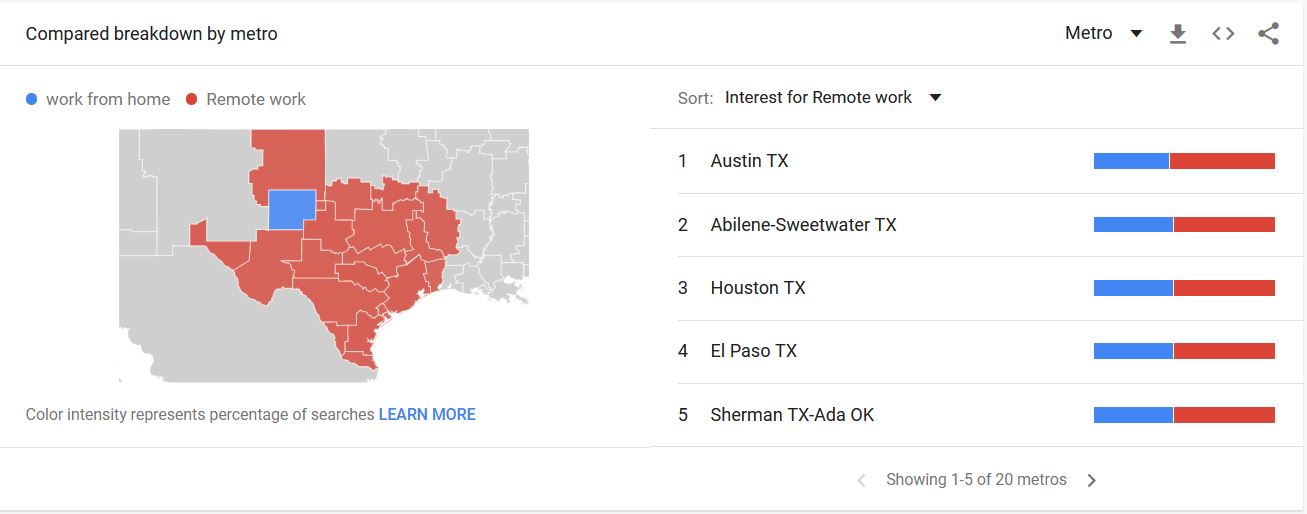Few anticipated the pandemic’s long term impact on the future of work. After all, restaurants and bars have bounced back, many have abandoned their Peloton in favor of gyms and international travel is now available. However, as we get closer to 2022, it is becoming more clear how work in an office will be forever different.
Texas Work from Home Trends from 2019 to 2022
Working from home has skyrocketed and is here to stay as employees prefer greater flexibility. Using Google Trends from 2019 to date in Texas, we notice a huge increase in March of 2020. Search interest for Work from home and remote work are both around double what they were pre pandemic.
Work from Home Trends by Texas Metro
Broken down by metro, there is high demand for remote work in some of the fastest growing and largest cities in Texas. DFW has a nearly 60/40% split for work from home and remote work.
While initially thought of as temporary, the rise of the delta variant and tight labor market have encouraged HR to adjust in person requirements Some tech startups now operate fully remote, giving up commercial real estate and office culture.
However, most businesses are experimenting with hybrid schedules. A few days in the office, a few days working from home. This small change in HR policies is creating flexible work environments, helping women return to the office, parents and those in multi-generation households.
The flexibility in schedules and hours is also upgrading the modern office in big ways. For Texas companies that are looking to attract workers, increase productivity and communication, learn how to adapt your office for hybrid workers. Doing so will improve the valuation of your building and deliver cost savings.
Hoteling and Hot Desking
These buzzwords aren’t well known outside of IT or coworking startups. However the death of the cubicle and rise of open floor plan offices has been a long time coming.
Hoteling and hot desking takes it a step further, untethering employees from a traditional desk and phone. Workstations can be a couch, meeting room, communal table, standing desk or even a telephone booth. WIthout any assigned seats, employees are free to check-in at an available desk, work then check-out (just like a hotel). At a workstation, employees can share a cloud phone and connect a laptop to wired internet. A smartphone app can securely unlock the desk phone and import all call history, contacts and notes. Active calls can even be transferred from smartphone to desk phone for a conference meeting.
Popularized at coworking spaces, hoteling is ideal for employers left with hundreds of unused on-premise phones and empty desks. Upgrading to a cloud based unified communication system, delivers voice over IP and hotel functionality. Save money on phone bills and hardware costs. Instead of needing a phone keyset for every employee, budget on how many are in the office at any time with some overage.
Sound Masking
This technology businesses didn’t know they needed until it was installed and experienced! Sound masking was first popular with call centers and customer service departments. However, it is now being installed in high tech startups to medical clinics and new construction high rises.
The discrete, yet powerful wireless speakers improve productivity and call quality by limiting background distractions and interference. Common in coworking environments and open concept office space to high traffic areas throughout DFW, Houston and Austin. Sound masking helps keep conversations private, and limits traffic noise and sirens without the need for cubicle walls or drop ceiling panels.
Strategic Meeting Rooms
One of the biggest changes to a physical office to support hybrid workers is the meeting room. Known by many names, which has evolved to accommodate new technologies and functions. Gone are the days of a single, executive boardroom. New construction and commercial retrofits in Texas are installing conference rooms, meeting and huddle spaces, Zoom rooms, Teams rooms, RingCentral in a box and more.
Smart conference rooms have a number of useful features including automated controls for screens, lighting, window shades and more. Room scheduling allows employees to share and book via any Calendar app or in person. Support for multiple video conferencing options or deeper level integrations with a single vendor are popular with businesses today.
Another trend is the number and variety of meeting areas. When retrofitting existing office buildings, consider fewer desk stations and more meeting rooms of different sizes. For a hybrid workforce, meetings and breakout areas are still needed to support collaboration, creativity and privacy. Design spaces for a variety of meeting types and group sizes (video conference, private phone call, digital whiteboards for brainstorming, in person presentations and more).
Cabling Connections
Finally, we can’t leave out network infrastructure as a critical upgrade for hybrid workers. Many new construction projects around Texas are building out fiber for faster video conferencing and internet connections. Within the building envelope, category 6e has become the new standard for connecting workstations, phones, video conference systems and in-building devices.
One of the benefits of upgrading networks is faster and more reliable internet, the ability to support VoIP and high definition video conferencing. Pair an upgraded connection with WIFI-6 which is now available and can power everything that requires an internet connection. Access points can deliver bandwidth and GB upload and download speeds where needed.
If you are considering a change in office technology to support your hybrid workers, get a quote from c2mtech. Our technicians have experience in retrofits to new construction.


